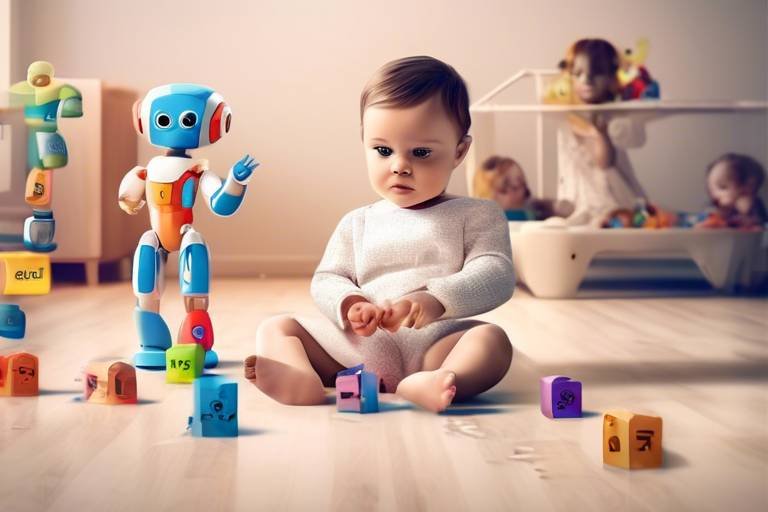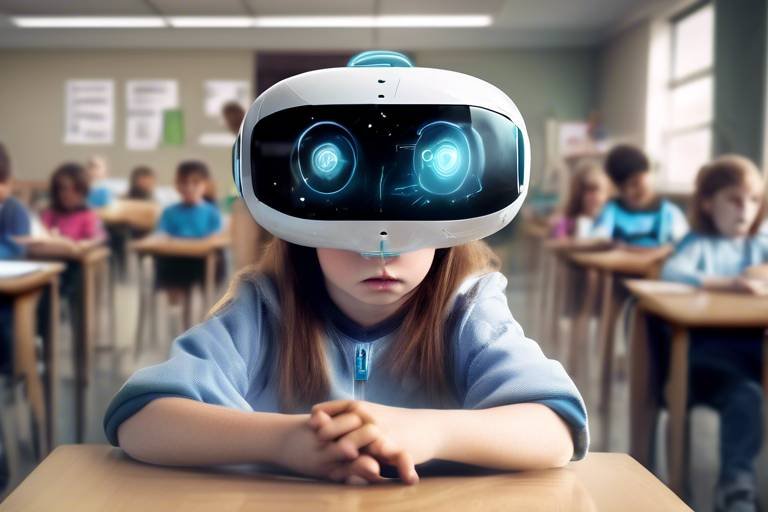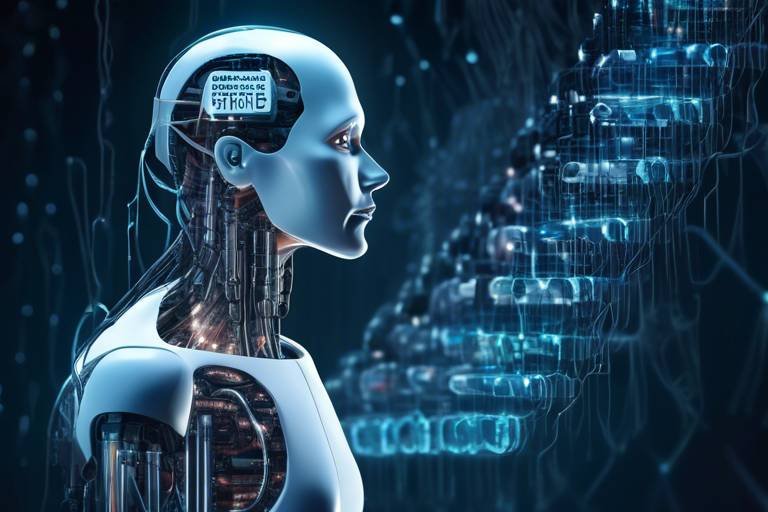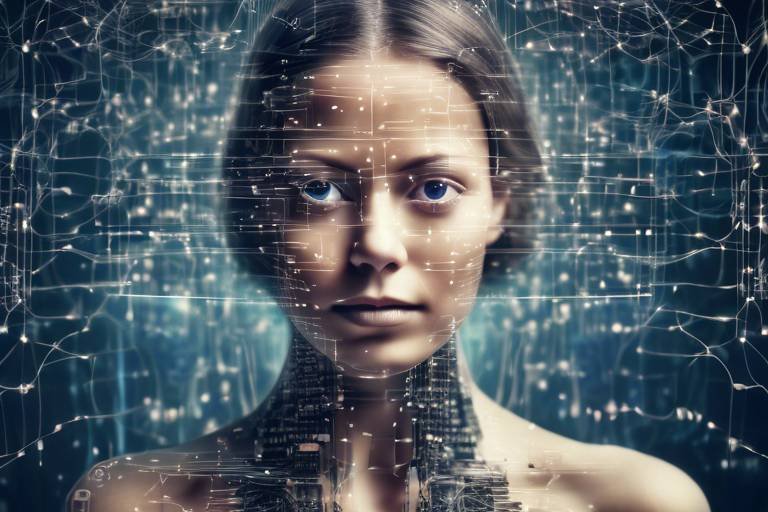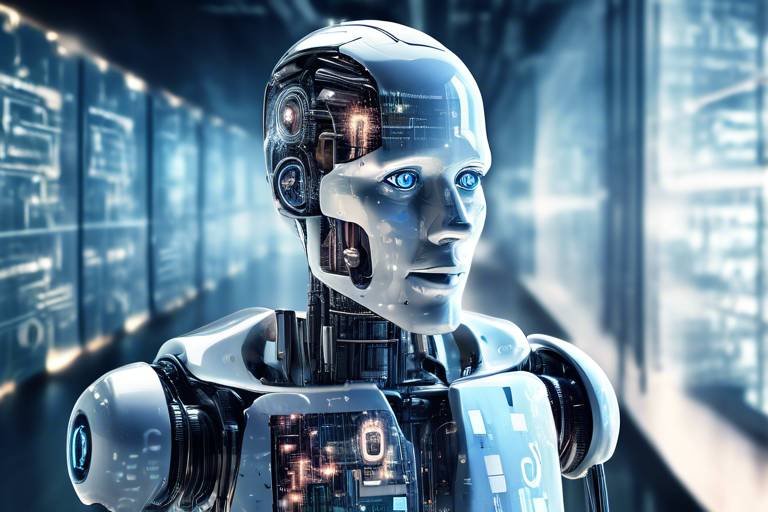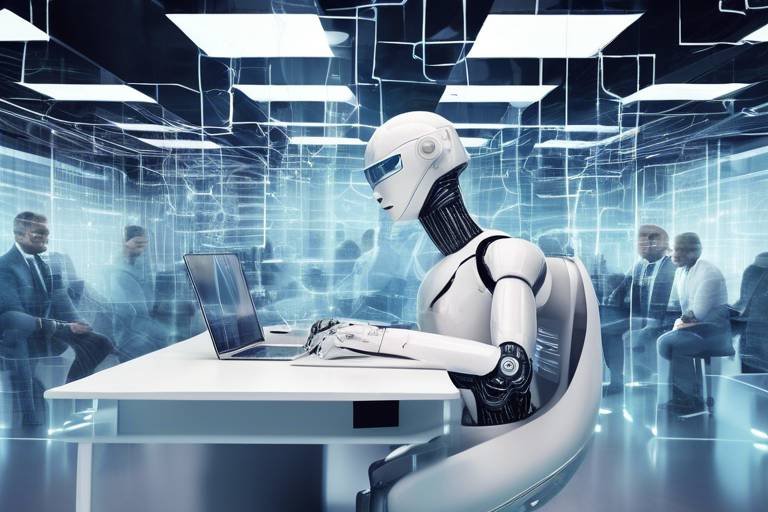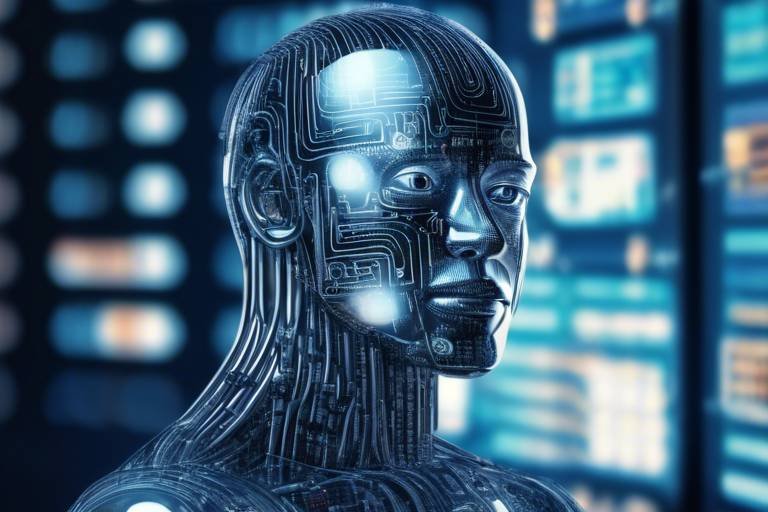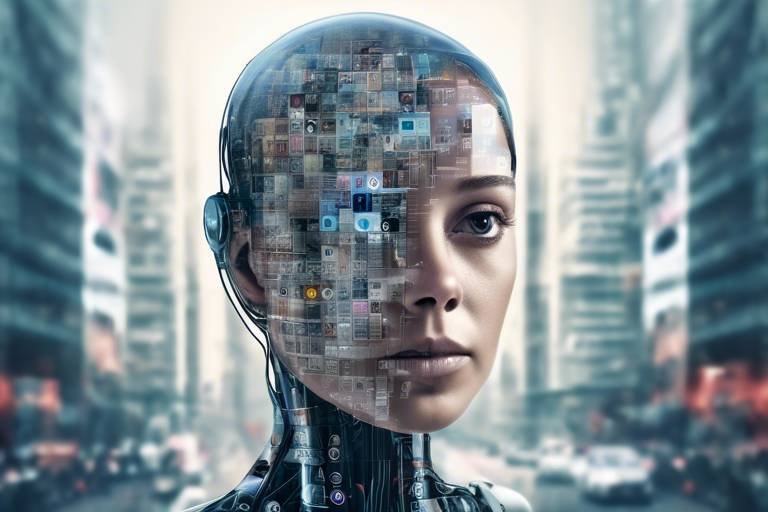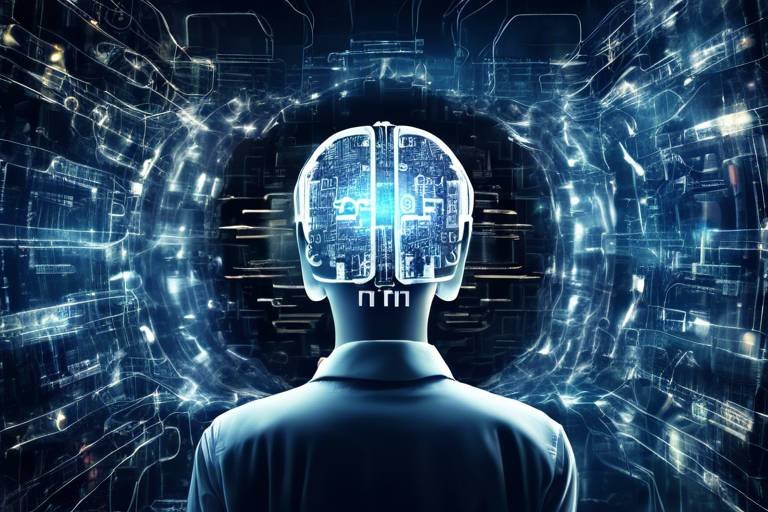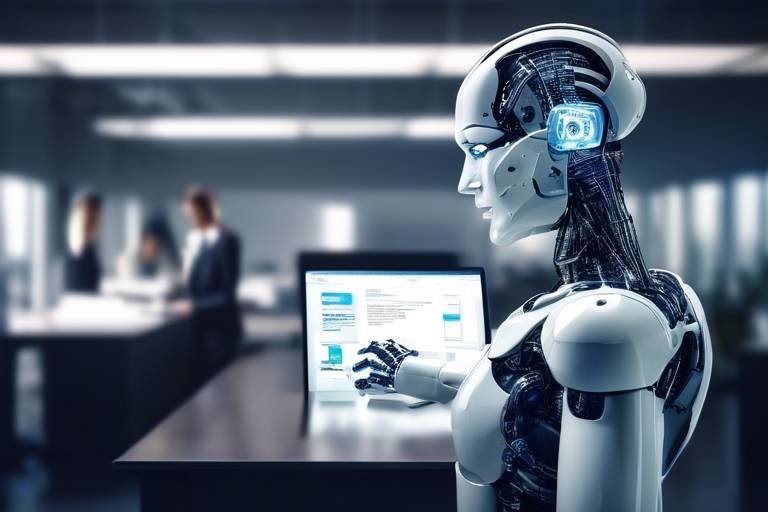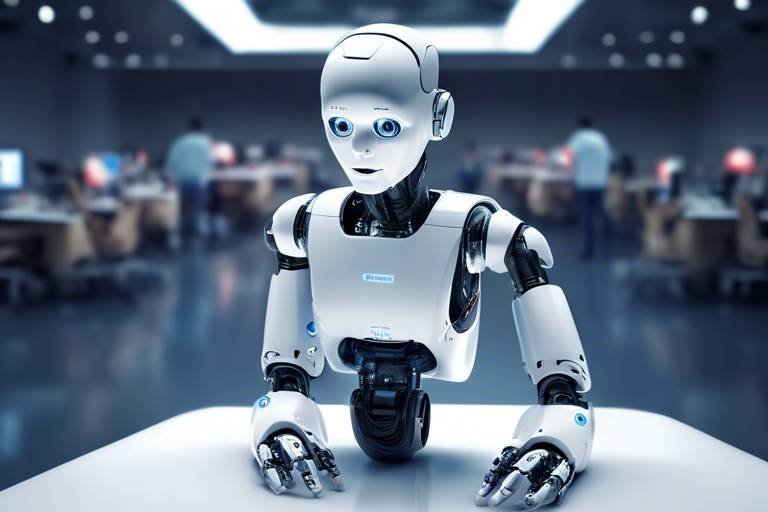The Future of Artificial Intelligence in Childcare
As we dive into the future of artificial intelligence (AI) in childcare, it's hard not to feel a sense of excitement mixed with curiosity. Imagine a world where technology seamlessly integrates into the daily lives of children, caregivers, and educators, enhancing every aspect of learning and development. AI is not just a buzzword; it's a transformative force that has the potential to revolutionize how we nurture and educate our little ones. From personalized learning experiences to advanced safety measures, AI is paving the way for a brighter, more efficient future in childcare.
Think about it: traditional methods of education often follow a one-size-fits-all approach. However, with AI, we can tailor lessons to meet the unique needs of each child. This means that every child can learn at their own pace, exploring subjects that ignite their curiosity while receiving support in areas where they struggle. It's like having a personal tutor available 24/7! Moreover, AI tools can analyze a child's progress, providing educators with insights that help them adjust their teaching strategies accordingly. This creates a more engaging and effective learning environment.
But the impact of AI in childcare goes beyond just education. Safety is a paramount concern for parents and caregivers alike. With the advent of smart monitoring systems equipped with AI, we can now ensure that children are safe in their environments. These systems can detect unusual activities and alert caregivers in real time, allowing for quick responses to potential dangers. Imagine the peace of mind that comes with knowing that technology is watching over our children, providing an extra layer of security while they learn and play.
Furthermore, as we explore the intersection of AI and emotional development, we find even more exciting possibilities. AI can help children understand their feelings, fostering emotional intelligence from a young age. Tools that recognize emotions through facial expressions and vocal tones can offer caregivers insights into how a child is feeling, allowing for timely support. This aspect of AI not only enhances safety but also nurtures the emotional well-being of children, ensuring they grow into resilient individuals.
However, with great power comes great responsibility. As we embrace AI in childcare, we must also consider the ethical implications. Data privacy is a significant concern, especially when it comes to our children. It's crucial to establish guidelines that protect sensitive information and ensure that AI technologies are used responsibly. Balancing technology with human interaction is essential; while AI can enhance learning and safety, it should never replace the emotional connections that are vital for healthy development.
In conclusion, the future of artificial intelligence in childcare is not just a distant dream; it's unfolding right before our eyes. With personalized learning experiences, enhanced safety measures, and support for emotional development, AI is set to transform how we care for and educate our children. As we navigate this exciting landscape, let's embrace the opportunities while remaining vigilant about the responsibilities that come with it. The journey ahead promises to be both thrilling and rewarding, paving the way for a new era in childcare.
- How is AI used in early childhood education? AI is utilized to create personalized learning experiences, allowing educators to tailor lessons to meet individual children's needs.
- What safety measures does AI provide in childcare? AI enhances safety through smart monitoring systems that detect unusual activities and alert caregivers in real time.
- Can AI support emotional development in children? Yes, AI can assist in emotional development by providing tools that help children understand and manage their feelings.
- What are the ethical concerns surrounding AI in childcare? Key concerns include data privacy, the potential impact on human interactions, and ensuring responsible usage of AI technologies.

The Role of AI in Early Childhood Education
Artificial Intelligence (AI) is rapidly changing the landscape of early childhood education, and the implications are both exciting and profound. Imagine a classroom where each child's unique learning style is recognized and nurtured, where lessons adapt in real-time to meet individual needs. That's not just a dream—it's becoming a reality through AI technologies. By harnessing the power of AI, educators can create highly personalized learning experiences that cater to the strengths and weaknesses of each child, fostering an engaging and effective learning environment.
One of the most remarkable aspects of AI in education is its ability to analyze data and provide insights that were previously difficult to obtain. For instance, AI can track a child's progress over time, identifying patterns in their learning that might suggest they need additional support or resources. This data-driven approach allows educators to intervene early, ensuring that no child is left behind. Furthermore, AI tools can facilitate interactive learning, making education more enjoyable and stimulating. Imagine children learning math through a game that adjusts its difficulty based on their responses, keeping them challenged yet not overwhelmed.
In addition to enhancing learning, AI also promotes collaboration among educators. With AI systems handling administrative tasks, teachers can focus more on what they do best: teaching and nurturing their students. AI can streamline lesson planning, grading, and even communication with parents, allowing educators to dedicate their time to creating meaningful connections with children and fostering a supportive classroom environment.
However, the integration of AI in early childhood education is not without its challenges. As we embrace these technologies, we must also consider the importance of maintaining a human touch in the learning process. While AI can provide invaluable support, it cannot replace the emotional connections that develop between educators and children. It's essential to strike a balance, ensuring that technology enhances rather than detracts from the educational experience.
In conclusion, the role of AI in early childhood education is transformative. It offers a unique opportunity to tailor learning experiences, enhance collaboration among educators, and ultimately, foster a more effective educational environment. As we move forward, it's crucial to remain mindful of the need for human interaction and emotional support, ensuring that our children not only learn but also grow in a nurturing and caring atmosphere.
- How does AI personalize learning for children? AI analyzes individual learning patterns and adapts educational content to suit each child's unique needs, ensuring a tailored learning experience.
- What are the benefits of AI in early childhood education? AI enhances engagement, provides valuable insights into child development, and allows educators to focus more on teaching rather than administrative tasks.
- Can AI replace teachers in the classroom? No, while AI can support and enhance the educational experience, it cannot replace the emotional connections and mentorship that teachers provide.

Enhancing Child Safety with AI
In today's fast-paced world, ensuring the safety of our children is more critical than ever. With the integration of artificial intelligence (AI) into childcare, we are witnessing a revolutionary change in how we approach child safety. AI technologies are not just tools; they are becoming essential partners in creating a secure environment for our little ones. Imagine a world where potential hazards are detected before they can cause harm, and caregivers are alerted to emergencies in real-time. This is not science fiction; this is the reality that AI is helping to shape.
One of the most exciting advancements in this area is the development of smart monitoring systems. These systems leverage AI algorithms to continuously track children's activities, providing caregivers with real-time updates. For instance, if a child wanders into a restricted area or engages in risky behavior, the system can alert the caregiver instantly. This proactive approach not only enhances safety but also allows caregivers to intervene before a situation escalates. It's like having a vigilant guardian watching over children, ensuring they can explore their surroundings without unnecessary risks.
Smart monitoring systems come equipped with various features that make them invaluable in childcare settings. They can analyze patterns in children's behavior, identifying any anomalies that may indicate potential danger. For example, if a child is unusually quiet for an extended period, the system can notify the caregiver, prompting them to check in. This capability transforms the way we think about supervision, shifting from reactive to proactive measures.
Another fascinating aspect of enhancing child safety through AI is the rise of wearable technology. These devices, such as smartwatches or health monitors, are designed specifically for children. They can track vital signs, monitor physical activity, and even provide GPS location tracking. Parents can stay informed about their child's well-being throughout the day, receiving alerts if something seems off. For instance, if a child's heart rate exceeds a certain threshold during play, the device can send an immediate notification to the parent. This level of connectivity offers peace of mind, allowing parents to feel more secure knowing they can monitor their child's health and safety from afar.
AI-powered surveillance solutions are also making waves in childcare safety. These systems analyze video feeds in real-time, using advanced algorithms to detect unusual activities. For example, if an unauthorized person enters a childcare facility, the system can trigger an alert, allowing staff to take immediate action. This technology not only helps maintain a secure environment but also fosters a sense of trust among parents, knowing that their children are being monitored by sophisticated systems designed to keep them safe.
Furthermore, AI can provide caregivers with data-driven insights that are crucial for understanding child development. By analyzing vast amounts of data, AI can help identify trends and patterns in children's behavior, allowing caregivers to tailor their approaches to meet individual needs. For instance, if data shows that a child is struggling with social interactions, caregivers can implement targeted activities to help them develop those skills. This personalized approach not only enhances safety but also supports overall child development.
As we embrace these technological advancements, it's essential to remember that while AI enhances safety, it should complement, not replace, human intuition and care. The blend of AI's capabilities with the warmth and understanding of caregivers creates a holistic approach to child safety that is both effective and nurturing.
- How does AI improve child safety in childcare settings?
AI enhances child safety by providing real-time monitoring, alerts for unusual behaviors, and data-driven insights that help caregivers respond promptly to potential risks.
- What are smart monitoring systems?
Smart monitoring systems leverage AI to track children's activities and alert caregivers to any unusual behavior, ensuring a proactive approach to safety.
- Can wearable technology really help keep children safe?
Yes, wearable technology can monitor children's health and location, providing parents with peace of mind and instant updates about their child's well-being.
- Are there any privacy concerns with AI in childcare?
Yes, the collection and use of children's data raise significant privacy concerns, necessitating strict regulations and transparent practices to protect sensitive information.

Smart Monitoring Systems
In today's fast-paced world, ensuring the safety of children is a top priority for parents and caregivers alike. leverage the power of artificial intelligence (AI) to provide real-time insights into children's activities, allowing caregivers to stay connected and informed. Imagine having a virtual guardian that not only watches over children but also alerts you to any unusual behavior or potential risks. This technology is a game-changer in the realm of childcare, creating a safer, more responsive environment.
These systems utilize a variety of sensors and cameras to monitor children's movements and interactions throughout the day. By analyzing data patterns, AI can detect anomalies that might indicate a safety concern. For instance, if a child wanders into an area they shouldn't be or exhibits signs of distress, the system can send instant notifications to caregivers via a smartphone app. This immediate feedback allows for quick intervention, ensuring that children remain safe and secure.
Furthermore, smart monitoring systems can be customized to fit the unique needs of each childcare setting. For example, in a daycare, multiple cameras can be strategically placed to cover all areas, while in a home environment, a single device might suffice. This adaptability is crucial, as it enables caregivers to maintain oversight without feeling overwhelmed by technology. In essence, these systems act as an extra pair of eyes, giving parents peace of mind while allowing children the freedom to explore and learn.
To illustrate the effectiveness of smart monitoring systems, consider the following table that outlines their key features:
| Feature | Description |
|---|---|
| Real-Time Alerts | Instant notifications sent to caregivers about unusual activities or emergencies. |
| Activity Tracking | Continuous monitoring of children's movements and interactions throughout the day. |
| Data Analysis | AI analyzes patterns to identify potential risks and enhance safety measures. |
| Customizable Settings | Adaptable to various childcare environments, from homes to daycare centers. |
In addition to enhancing safety, these systems also foster a sense of community among caregivers. By sharing insights and experiences, caregivers can learn from one another and improve their practices. This collaborative approach not only strengthens the safety protocols but also builds trust and camaraderie within the childcare community.
As we embrace the future of childcare, it's essential to recognize the potential of smart monitoring systems. They represent a harmonious blend of technology and care, ensuring that children can thrive in a secure environment while caregivers maintain the necessary oversight. The journey towards safer childcare is just beginning, and with AI at the forefront, the possibilities are truly exciting.
- How do smart monitoring systems work? Smart monitoring systems utilize cameras and sensors to track children's activities and send real-time alerts to caregivers about any unusual behavior or potential risks.
- Are smart monitoring systems customizable? Yes, these systems can be tailored to meet the specific needs of different childcare environments, whether at home or in daycare facilities.
- What are the benefits of using smart monitoring systems? They enhance child safety, provide real-time insights, and foster a sense of community among caregivers.
- Can these systems be integrated with other childcare technologies? Absolutely! Smart monitoring systems can often be integrated with other technologies for a more comprehensive approach to childcare.

Wearable Technology for Kids
In today's fast-paced world, is becoming a game-changer in childcare. Imagine a small device that not only tracks your child's location but also monitors their health and activity levels. These smart gadgets are designed to provide parents with peace of mind while allowing children the freedom to explore their surroundings. With features such as GPS tracking, heart rate monitoring, and even emergency alerts, wearable technology is revolutionizing how we think about child safety.
One of the most exciting aspects of these devices is their ability to connect directly to smartphones or tablets. This means that parents can receive real-time updates about their child's well-being, no matter where they are. For instance, if your child has wandered too far from a designated safe zone, the device can send an immediate alert, ensuring that you can take action quickly. It's like having a digital safety net that keeps your little ones secure while they grow and learn.
Moreover, these devices often come equipped with features that encourage healthy habits. For example, some wearables can track physical activity, reminding children to stay active and engage in sports or play. This not only promotes physical health but also helps instill a sense of responsibility in children regarding their own well-being. Just think of it as a personal coach that fits right on their wrist!
However, while the benefits are substantial, it's essential to consider the privacy implications of wearable technology. Parents should ensure that the devices they choose have robust security measures in place to protect their child's data. Many manufacturers are now prioritizing data encryption and user privacy, making it easier for parents to feel secure about their child's information.
In summary, wearable technology for kids is not just about tracking their location; it's about enhancing their overall safety and promoting healthy lifestyles. As these devices continue to evolve, they will undoubtedly play a crucial role in the future of childcare, providing both parents and children with the tools they need to thrive in a modern world.
- What types of wearable technology are available for kids?
There are various types of wearables, including smartwatches, fitness trackers, and GPS-enabled devices designed specifically for children. - Are wearable devices safe for children?
Most wearable devices are designed with safety in mind, featuring parental controls and data encryption to protect children's information. - How can wearable technology benefit my child's health?
Wearable technology can encourage physical activity, monitor heart rates, and help children develop healthy habits from a young age. - What should I look for when choosing a wearable device for my child?
Consider features like GPS tracking, health monitoring, battery life, and data privacy protections when selecting a wearable device.

AI-Powered Surveillance Solutions
In an age where safety is paramount, are stepping up to revolutionize how we monitor childcare environments. Imagine a world where every corner of a childcare facility is under the watchful eye of intelligent systems that can detect anomalies and alert caregivers in real-time. These advanced technologies do not just record footage; they analyze it, providing insights that can enhance the safety of children in their care.
At the heart of these surveillance systems are sophisticated algorithms that can process video feeds, identifying unusual activities that may signal potential risks. For instance, if a child wanders off from a designated play area or if there’s a sudden altercation between children, the AI can immediately notify caregivers. This proactive approach means that instead of waiting for something to go wrong, caregivers can act swiftly to prevent incidents before they escalate.
Moreover, the integration of AI in surveillance is not just about monitoring but also about learning. These systems can adapt over time, becoming more adept at recognizing patterns and behaviors specific to the childcare setting. This means that the more they observe, the better they get at distinguishing between normal play and potential danger. For example, if a child frequently plays near a particular area, the system can learn this behavior and adjust its alerts accordingly, reducing false alarms and focusing on genuine concerns.
But how does this technology work in practice? Here’s a quick breakdown:
| Feature | Description |
|---|---|
| Real-Time Alerts | Instant notifications sent to caregivers when unusual activities are detected. |
| Behavior Analysis | Continuous learning algorithms that adapt to the unique behaviors of children. |
| Remote Monitoring | Access to live feeds via mobile devices, allowing caregivers to monitor from anywhere. |
| Data Storage | Secure storage of footage for future review and analysis. |
Additionally, these AI-powered systems can also integrate with other technologies, such as wearable devices. For instance, if a child wearing a smart bracelet strays too far from a designated area, the surveillance system can receive a signal and alert the caregivers immediately. This interconnectedness not only enhances safety but also fosters a sense of security among parents, knowing that their children are being monitored by intelligent systems that prioritize their well-being.
However, with great power comes great responsibility. The deployment of AI-powered surveillance solutions raises important questions about privacy and consent. It's essential for childcare facilities to establish clear guidelines on how data is collected, stored, and used, ensuring that the technology serves to protect and not invade the privacy of children and families. Transparency in these practices will be crucial in building trust among parents and caregivers.
In conclusion, AI-powered surveillance solutions are paving the way for a safer childcare environment, combining cutting-edge technology with the human touch needed to nurture and protect our youngest generation. As we embrace these innovations, it's vital to remain vigilant about the ethical implications, ensuring that our pursuit of safety does not compromise the values we hold dear.
- What are AI-powered surveillance solutions? AI-powered surveillance solutions use advanced algorithms to analyze video feeds in real-time, detecting unusual activities and alerting caregivers to potential risks.
- How do these systems enhance child safety? By providing real-time alerts and behavior analysis, these systems allow caregivers to respond swiftly to any safety concerns, helping to prevent incidents before they escalate.
- Are there privacy concerns with AI surveillance? Yes, the use of AI in surveillance raises important questions about data privacy and consent. It is crucial for childcare facilities to have clear guidelines on data usage.
- Can AI surveillance integrate with other technologies? Absolutely! AI surveillance can work alongside wearable devices to provide a more comprehensive safety net for children.

Data-Driven Insights for Caregivers
In today's rapidly evolving world, data-driven insights are becoming a game changer for caregivers in the realm of childcare. Imagine having a personal assistant that not only tracks children's progress but also provides actionable recommendations tailored to each child's unique needs. This is where artificial intelligence (AI) steps in, analyzing vast amounts of data to help caregivers make informed decisions that promote optimal child development.
AI systems can evaluate various aspects of a child's growth, from cognitive skills to social interactions. By processing data collected from various sources—such as educational apps, wearable devices, and even direct observations—AI can highlight patterns and trends that may not be immediately apparent to caregivers. For instance, if a child is struggling with a particular concept in math, the AI can suggest targeted activities or resources to help reinforce that learning.
Moreover, these insights can lead to more effective communication between caregivers and parents. Caregivers can share detailed reports on a child's progress, pinpointing areas of strength and those needing improvement. This transparency fosters a collaborative environment where both parties can work together to support the child's development. Picture this: a caregiver sending a weekly update to parents that includes not just grades, but also emotional well-being indicators, social engagement levels, and even suggestions for at-home activities that align with what the child is learning.
Additionally, AI can assist in identifying early signs of developmental delays or challenges. By continuously monitoring children's interactions and responses, AI can flag potential issues, allowing caregivers to address them proactively. This early intervention can make a significant difference in a child's developmental trajectory. For example, if a child shows signs of difficulty in language development, the AI might recommend specific speech therapy exercises that can be integrated into daily activities.
Here's a brief overview of how data-driven insights can empower caregivers:
| Benefit | Description |
|---|---|
| Personalized Learning | AI tailors educational content to fit each child's learning style and pace. |
| Early Detection | Identifies potential developmental issues early on for timely intervention. |
| Enhanced Communication | Facilitates detailed updates and collaborative efforts between caregivers and parents. |
| Resource Recommendations | Suggests specific activities and resources based on individual child assessments. |
In conclusion, the integration of AI into childcare is not just about technology; it's about enhancing the human experience. By providing caregivers with data-driven insights, AI enables them to nurture children more effectively, ensuring that every child has the support they need to thrive. As we continue to embrace these innovations, the future of childcare looks not only brighter but also more personalized and responsive to each child's needs.
- How does AI analyze children's data?
AI uses algorithms to process data from various sources, identifying patterns and trends in a child's development. - Can AI replace human caregivers?
No, AI is designed to assist caregivers, not replace them. Human interaction remains essential for emotional and social development. - What measures are in place to protect children's data?
Strict regulations and transparent practices are necessary to ensure the privacy and security of children's data. - How can parents get involved with AI insights?
Parents can collaborate with caregivers by discussing AI-generated reports and participating in suggested activities.

AI and Emotional Development
Artificial intelligence is not just about crunching numbers or automating tasks; it has the potential to revolutionize emotional development in children. Imagine a world where technology can help kids understand their feelings better, enabling them to navigate the complexities of their emotions with ease. AI can serve as a bridge, connecting children with the tools they need to build resilience and emotional intelligence from a young age. This is not just a futuristic dream; it's happening right now!
One of the most exciting advancements in this area is the emergence of emotion recognition technologies. These cutting-edge tools utilize AI algorithms to assess children's emotional states by analyzing their facial expressions, vocal tones, and even body language. For instance, if a child is feeling anxious or upset, the technology can provide real-time feedback to caregivers, allowing them to respond with the appropriate support. This not only enhances the caregiver's ability to nurture but also empowers children to articulate their feelings more effectively.
Moreover, we are witnessing the rise of interactive AI companions that engage children in meaningful conversations and activities. These AI entities are designed to simulate real-life interactions, offering a safe space for kids to practice social skills and emotional awareness. Just think about it: a child can talk to an AI about their day, share their worries, or even role-play different scenarios to understand various emotional responses. This kind of interaction can be incredibly beneficial, especially for those who may struggle with social cues or emotional expression.
It's important to note that while these technologies offer tremendous benefits, they should not replace human interaction. Instead, they should complement the nurturing environment provided by parents and caregivers. The goal is to create a balance where technology enhances emotional development without overshadowing the essential human connections that are crucial for a child’s growth.
As we venture further into this AI-driven age, we must also consider the ethical implications of using such technologies in childcare. Questions about data privacy, the accuracy of emotion recognition, and the potential for over-reliance on technology need to be addressed. Are we ready to trust AI with our children's emotional well-being? This is a conversation that demands our attention as we embrace these innovations.
In conclusion, the integration of AI into emotional development is a double-edged sword. On one hand, it offers unprecedented opportunities for enhancing children's emotional intelligence and resilience. On the other hand, it challenges us to think critically about how we implement these technologies responsibly. As we navigate this new landscape, let's ensure that our focus remains on fostering healthy emotional growth for our children, blending the best of technology with the irreplaceable value of human connection.
- How does AI help in emotional development? AI technologies can analyze emotional cues and provide insights to caregivers, helping them support children's emotional needs effectively.
- Are interactive AI companions safe for children? While interactive AI can be beneficial, it's essential to monitor their use and ensure they complement human interaction rather than replace it.
- What are the ethical concerns regarding AI in childcare? Key concerns include data privacy, the accuracy of emotional assessments, and the potential impact on human relationships.

Emotion Recognition Technologies
In today's fast-paced world, understanding emotions has become more important than ever, especially for children who are still learning to navigate their feelings. , powered by artificial intelligence, are stepping in to bridge this gap. These innovative systems analyze various indicators, such as facial expressions and vocal tones, to assess a child's emotional state. Imagine a world where a child's smile or frown triggers immediate feedback for caregivers—this is the power of AI in emotional recognition.
These technologies work by utilizing advanced algorithms that process visual and auditory data. For instance, a camera equipped with emotion recognition software can detect subtle changes in a child's facial expressions, while voice analysis can pick up on the emotional undertones in their speech. This dual approach offers a comprehensive understanding of a child's feelings, allowing caregivers to respond appropriately. It's like having a personal emotional guide that helps adults understand what children are going through, even when words may fail them.
Furthermore, the potential applications of emotion recognition technologies are vast. In educational settings, teachers can receive real-time feedback on how students are feeling during lessons. If a child appears confused or frustrated, the teacher can pivot their approach to better suit the child's emotional needs. This adaptability can lead to a more supportive learning environment, where emotional well-being is prioritized alongside academic achievement.
However, it's essential to consider the implications of using such technology. While the benefits are clear, there are also ethical considerations that must be addressed. For instance, the accuracy of emotion recognition systems can vary, leading to potential misunderstandings of a child's feelings. Moreover, the data collected raises serious privacy concerns that cannot be overlooked. As we embrace these technologies, we must also ensure that they are implemented responsibly, with strict guidelines to protect children's sensitive information.
In conclusion, emotion recognition technologies hold tremendous promise for enhancing the emotional development of children. By providing caregivers with valuable insights into a child's emotional state, these systems can foster a nurturing environment that supports healthy emotional growth. As we continue to explore the capabilities of AI in childcare, we must remain vigilant in addressing ethical concerns and ensuring that technology complements, rather than replaces, human interaction.
- What are emotion recognition technologies?
These are AI-powered systems that analyze facial expressions and vocal tones to assess a person's emotional state.
- How can these technologies benefit childcare?
They provide caregivers with insights into children's emotions, helping them respond appropriately to their needs.
- Are there any ethical concerns associated with emotion recognition?
Yes, concerns include privacy issues and the potential for misinterpretation of emotional states.
- Can emotion recognition technologies replace human interaction?
No, while they can support emotional understanding, they should complement human interactions rather than replace them.

Interactive AI Companions
Imagine a world where your child has a friendly companion that is always there to listen, engage, and learn alongside them. are revolutionizing how children interact with technology, providing a unique blend of entertainment and education. These digital friends are designed to engage children in meaningful conversations and activities, simulating real-life interactions in a safe and controlled environment. It's like having a buddy who can play games, tell stories, or even help with homework, all while adapting to your child's individual learning style!
One of the most exciting aspects of these AI companions is their ability to foster social skills and emotional awareness in children. By engaging in conversations, these companions can help children express their feelings and understand the emotions of others. For instance, when a child talks about their day, the AI can respond with empathy, encouraging them to articulate their thoughts and feelings more effectively. This interaction not only promotes emotional intelligence but also builds a child's confidence in social situations.
Moreover, interactive AI companions can be tailored to meet the specific needs of each child. They can adapt their responses based on a child’s mood, interests, and developmental stage. This personalized approach makes learning more engaging and effective. For example, if a child shows interest in dinosaurs, the AI can incorporate fun facts and games related to dinosaurs, turning learning into an exciting adventure. How cool is that?
Additionally, these AI companions can serve as a bridge between children and real-world experiences. They can encourage kids to explore their surroundings, ask questions, and seek out new experiences. Imagine an AI that prompts your child to go outside and observe nature, or to think critically about a story they just heard. This kind of interaction can spark curiosity and creativity, essential components for a child’s growth and development.
However, it's important to remember that while these companions offer numerous benefits, they should complement, not replace, human interaction. Children still need the warmth and emotional support that comes from family, friends, and caregivers. Striking the right balance between technology and human connection is key to ensuring children develop holistically.
In summary, interactive AI companions are more than just toys; they are tools that can enhance a child's learning and emotional development. By providing a safe space for exploration and expression, these AI companions can help children navigate their feelings and build essential social skills, all while making learning a fun and engaging experience.
- What are interactive AI companions?
They are digital entities designed to engage children in conversations and activities, promoting learning and emotional intelligence. - How do they enhance learning?
They tailor interactions based on a child's interests and developmental stage, making learning personalized and engaging. - Are they safe for children?
Yes, when used appropriately, they provide a safe environment for children to explore and learn. However, parental supervision is recommended. - Can they replace human interaction?
No, while they offer valuable support, human interaction is crucial for a child's emotional and social development.

The Ethical Considerations of AI in Childcare
As artificial intelligence (AI) becomes increasingly integrated into childcare settings, it brings about a plethora of ethical considerations that cannot be overlooked. One of the most pressing issues is data privacy. With AI systems collecting vast amounts of data on children's behaviors, preferences, and even emotional states, the question arises: how is this sensitive information being stored, used, and protected? The potential for misuse or unauthorized access to this data poses significant risks, not just to children but also to parents and caregivers. Therefore, it is crucial for developers and childcare providers to implement stringent data protection measures and adhere to strict regulations that prioritize children’s privacy.
Moreover, the reliance on AI technologies in childcare settings raises concerns about the balance between technology and human interaction. While AI can enhance learning and safety, it is essential to ensure that children do not miss out on the emotional support that only human caregivers can provide. After all, children thrive on social interactions, and the warmth of a human touch cannot be replicated by machines. Striking the right balance between utilizing AI tools and maintaining personal connections is vital for fostering a nurturing environment where children can grow emotionally and socially.
Another ethical consideration revolves around the potential for bias in AI algorithms. If not carefully designed, AI systems can inadvertently perpetuate existing biases present in the data they are trained on. This can lead to unfair treatment or misinterpretation of children's behaviors based on their backgrounds or characteristics. Therefore, it is essential for developers to ensure that AI systems are transparent and regularly audited to mitigate biases and promote fairness in childcare practices.
In addition to these concerns, there is a need for ongoing discussions among stakeholders, including parents, educators, and policymakers, to establish clear guidelines for the responsible use of AI in childcare. These discussions should address questions such as:
- What are the best practices for data collection and storage?
- How can we ensure that AI tools complement rather than replace human interactions?
- What measures should be in place to prevent bias in AI algorithms?
By engaging in these conversations, we can pave the way for a future where AI enhances childcare while safeguarding children's rights and well-being. As we navigate this evolving landscape, it is imperative to remain vigilant and proactive in addressing the ethical challenges that AI presents.
Q1: What are the main ethical concerns regarding AI in childcare?
A1: The primary ethical concerns include data privacy, the balance between technology and human interaction, and the potential for bias in AI algorithms.
Q2: How can we ensure the safety of children's data?
A2: Implementing strict data protection measures, adhering to regulations, and promoting transparency in data usage are crucial for safeguarding children's information.
Q3: Why is human interaction still important in childcare despite the advancements in AI?
A3: Human interaction provides emotional support and social experiences that are essential for children's healthy development, which AI cannot replicate.

Data Privacy Concerns
As we venture into the brave new world of AI in childcare, one of the most pressing issues we face is data privacy. The very nature of artificial intelligence involves collecting and analyzing vast amounts of data, and when it comes to children, this raises significant ethical questions. After all, children are not just data points; they are individuals with rights that must be respected and protected.
Imagine a scenario where an AI system tracks a child's daily activities, learning patterns, and even their emotional responses. While this information can be invaluable for tailoring educational experiences, it also presents a treasure trove of sensitive data that could be misused if it falls into the wrong hands. The potential for data breaches or unauthorized access to this information is a real concern for parents and caregivers alike.
To put it simply, we must ask ourselves: how can we ensure that the data collected is used responsibly? Here are some critical considerations:
- Transparency: Parents deserve to know what data is being collected, how it is used, and who has access to it.
- Consent: Obtaining informed consent from parents before collecting any data is essential to uphold ethical standards.
- Regulations: Implementing strict regulations to govern data collection and usage can help protect children's privacy.
Moreover, the conversation about data privacy isn't just about the present; it’s also about the future. As children grow up in a world where their every move might be monitored by AI, we must consider the long-term implications of this surveillance. Are we inadvertently teaching them that their privacy is negotiable? Or are we fostering a culture of awareness about the importance of data protection?
In conclusion, while AI holds incredible potential to enhance childcare and education, we must tread carefully. Balancing the benefits of data-driven insights with the need for robust privacy protections is crucial. As we move forward, let’s ensure that the voices of parents, caregivers, and even children are included in the discussions about how to navigate this complex landscape.
- What data does AI collect in childcare settings? AI systems may collect data on children's activities, learning progress, health metrics, and emotional responses.
- How is children's data protected? Data protection measures include encryption, access controls, and compliance with regulations like COPPA (Children's Online Privacy Protection Act).
- Can parents opt-out of data collection? Yes, parents should have the option to opt-out of data collection and be informed about how to do so.
- What happens if there is a data breach? In the event of a data breach, organizations must have protocols in place to notify affected parties and mitigate any potential harm.

Balancing Technology and Human Interaction
In the rapidly evolving landscape of childcare, finding the sweet spot between technology and human interaction is more crucial than ever. While artificial intelligence offers exciting opportunities to enhance learning and safety, it is essential to remember that children are inherently social beings. They thrive on real-world interactions, emotional connections, and the warmth of human touch. Imagine a child learning to ride a bike; the thrill of wobbly independence is often coupled with the encouraging cheers of a parent or caregiver. That moment of support is irreplaceable and cannot be replicated by a machine.
AI can undoubtedly assist in many areas—like tracking developmental milestones or providing personalized learning experiences—but it should never become a substitute for the nurturing relationships that children need. For instance, while an AI system might analyze a child's learning patterns, it cannot provide the emotional reassurance that comes from a caregiver's comforting presence. Therefore, it's vital to integrate technology in a way that complements rather than replaces human interaction.
To achieve this balance, caregivers can adopt a hybrid approach. This might involve using AI tools to handle administrative tasks or monitor safety, allowing caregivers to focus more on engaging with the children. For example, AI can help in identifying when a child is struggling with a particular concept, enabling caregivers to step in and provide targeted support. This way, technology acts as a supportive ally, freeing up time for meaningful, face-to-face interactions that foster emotional and social development.
Moreover, caregivers should be mindful of the quality of interactions they provide. Engaging in conversations, playing games, and simply being present are all vital components of a child's growth. Research suggests that children learn best when they are actively engaged in their environment, and this engagement is often sparked by human interaction. Thus, while AI can offer valuable insights, it is the human touch that truly nurtures a child's spirit.
In summary, the integration of AI in childcare should be approached with caution and intentionality. By ensuring that technology serves to enhance rather than replace human interaction, we can create a nurturing environment where children feel safe, supported, and understood. After all, the ultimate goal is to raise well-rounded individuals who can navigate both the digital world and the complexities of human relationships.
- How can AI improve the learning experience for children?
AI can tailor educational content to meet individual learning needs, providing personalized feedback and facilitating a more engaging learning environment. - What are the risks associated with AI in childcare?
Potential risks include data privacy concerns, over-reliance on technology, and reduced human interaction, which is essential for emotional development. - How can caregivers ensure a balance between technology and human interaction?
Caregivers can leverage AI for administrative tasks while focusing on engaging children through play, conversation, and emotional support. - Are there specific AI tools recommended for childcare?
There are various AI tools designed for monitoring and learning, but it is essential to choose those that prioritize child safety and data privacy.
Frequently Asked Questions
- How is AI transforming early childhood education?
AI is revolutionizing early childhood education by providing personalized learning experiences. This means educators can tailor lessons to fit each child's unique needs and progress, creating a more engaging and effective learning environment.
- What role does AI play in enhancing child safety?
AI significantly enhances child safety through advanced monitoring systems that detect potential hazards and alert caregivers to emergencies. This technology ensures a secure environment for children to grow and learn.
- What are smart monitoring systems?
Smart monitoring systems utilize AI to track children's activities in real-time, providing caregivers with updates and enabling quick responses to any unusual behavior or potential risks in childcare settings.
- How does wearable technology contribute to child safety?
Wearable technology equipped with AI capabilities helps monitor children's health and location. This ensures their safety while allowing parents to stay informed about their well-being throughout the day.
- What are emotion recognition technologies?
Emotion recognition technologies powered by AI assess children's emotional states through facial expressions and vocal tones. This provides valuable feedback to caregivers on how to support children's emotional needs effectively.
- What ethical concerns are associated with AI in childcare?
As AI becomes more integrated into childcare, ethical concerns arise regarding privacy, data security, and the impact on human interactions. It's essential to have discussions and guidelines to ensure responsible usage.
- How can AI support children's emotional development?
AI can assist in children's emotional development by providing tools that help them understand and manage their feelings. Interactive AI companions engage children in conversations, helping them develop social skills and emotional awareness.
- What is the importance of balancing technology and human interaction?
While AI can enhance childcare, maintaining a balance between technology and human interaction is crucial. Children need emotional support and social experiences that are essential for their healthy development.

